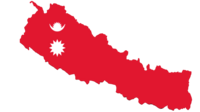
Kathmandu, officially Kathmandu Metropolitan City, is the capital and most populous city of Nepal with 845,767 inhabitants living in 105,649 households as of the 2021 Nepal census and 2.9 million people in its urban agglomeration. It is located in the Kathmandu Valley, a large valley in the high plateaus in central Nepal, at an altitude of 1,400 metres.
The Kusunda or Ban Raja, known to themselves as the Mihaq or Myahq, are a tribe of former hunter-gatherers of the forests of western Nepal, who are now intermarried with neighboring peoples and settled in villages.
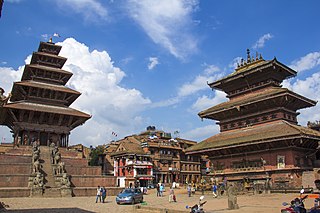
Bhaktapur, known locally as Khwopa and historically called Bhadgaon, is a city in the east corner of the Kathmandu Valley in Nepal located about 13 kilometres (8.1 mi) from the capital city, Kathmandu. Bhaktapur is the smallest city of Nepal as well the most densely populated. Along with Kathmandu and Lalitpur, Bhaktapur is one of the three main cities of the Kathmandu Valley and is a major Newar settlement of the country. The city is also known for its Newar tradition, cuisine and artisans. Bhaktapur suffered heavy damage in the April 2015 earthquake.
The Magars, also spelled Mangar and Mongar, are ethnolinguistic groups to Western Nepal and Northeast India, representing 6.9% of Nepal's total population according to the 2021 Nepal census.
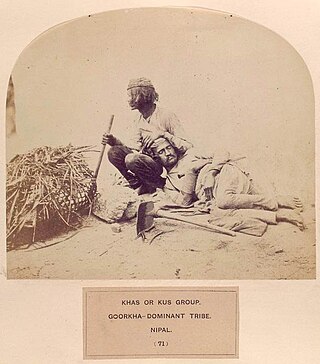
Khas tribe, popularly known as Khashya, according to the 2015 constitution of Nepal are an Indo-Aryan ethno-linguistic group native to the Himalayan region of the Indian subcontinent, in what is now the present-day South Asian country of Nepal, as well as the Indian states of Uttarakhand, West Bengal and Sikkim. Historically, Khas were the speakers of an ancient Khas language from the Indo-Aryan language family and the earliest recorded speakers of the Western Pahari languages. The large portion of the Indo-Aryan speakers throughout lower Himalayas were the Khas people. An intrusion of this tribe from the Western and Northwestern Himalayas into Central Himalayas is substantiated by the early linguistic evidences related to the Nepali language. They were also known as Parbatiyas/Parbates and are currently known as Paharis/Pahadis.. They were also referred to as Yartse in Tibet and are also known as Khasan by Bhotia people. The term Khas has now become obsolete, as the Khas people have adopted communal identities because of the negative stereotypes associated with the term Khas. In Nepal the native speaker of Nepali language are known as Khas.
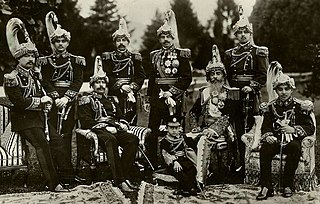
The Rana dynasty were a Chhetri dynasty that imposed authoritarianism in the Kingdom of Nepal from 1846 until 1951, reducing the Shah monarch to a figurehead and making the Prime Minister and other government positions held by the Ranas hereditary. They are Kshatriya, whose ancestors were descended from the Ranas of Udaipur, Rajasthan, India. The Rana dynasty is historically known for their iron-fisted rule. This changed after the Revolution of 1951 with the promulgation of a new constitution, when power shifted back to the monarchy of King Tribhuvan.

Christianity is, according to the 2011 census, the fifth most practiced religion in Nepal, with 375,699 adherents, or 1.4% of the population. Many informed observers have estimated that there are at least 1 million Nepali Christians. According to some Christian groups, there may be as many as 3 million Christians in Nepal, constituting up to 10% of the country's population. A report by Gordon Conwell Theological Seminary identified the Nepali church the fastest growing in the world. The vast majority of Nepali Christians are evangelical Protestants ; there is also a small Catholic population of roughly 10,000.

General elections were held in Nepal on 9 May 1981 to elect members of the Rastriya Panchayat. 80% of the seats were elected through adult universal suffrage; this was the first election through universal suffrage held in Nepal in 22 years. However, political parties were banned at the time, and the main underground opposition forces called for a boycott of the election.

Prithvi Narayan Campus or P.N. Campus,(Nepali: पृथ्वीनारायण क्याम्पस) is a public co-educational institution located in the northern part of the Pokhara city and is one of the largest campuses affiliated to the TU. The institution offers undergraduate(Bachelors) and graduate programmes. It is named after the great king; Prithvi Narayan Shah.
Bahun, also known as Hill Brahmins, are a Brahmin varna among the Khas of Nepal. Their origins are from the Himalayan belt of South Asia. According to the 2011 Nepal census, Bahun is the second most populous group after Chhetri.
Michael James Hutt is Professor of Nepali and Himalayan Studies at the School of Oriental and African Studies (SOAS), University of London. He is engaged in the study of modern and contemporary Nepali literature, and as a translator. He has also published on Nepali politics, Nepali art and architecture, censorship in the Nepali print media, and the Bhutanese refugee issue.
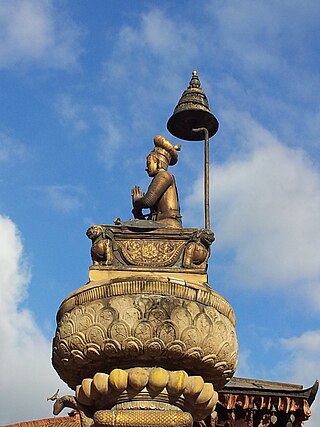
The Śreṣṭha or is the second largest Newar caste group, occupying around 21% of overall Newar population, or about 1.1% of Nepal’s total population. It is believed that the word Srēṣṭha is derived from the Newar word Śeśyah, which itself is derivation of a Sanskrit word Sista meaning 'noble', although literal meaning of the word also translated to 'best or important.' "Shrestha" itself was later adopted as the specific family surname by members of this high-caste Hindu group, although there are over 50 other recognized surnames of Srēṣṭhas. Despite their numerically low national population, their high-status and socio-economic capital puts Śreṣṭhas amongst the most socio-economically privileged and politically over-represented segments of Nepali population.

People of Nepal is a 1967 book by Dor Bahadur Bista. The book is the first relatively comprehensive view of the vast array of Nepalese cultures, castes and ethnic groups, with descriptions of their unique customs. It is written by anthropologist Dor Bahadur Bista.

A Bhadgaunle Topi or Kalo Topi is a type of hat worn by Nepalis and Indian Gorkhas. The hat has been adopted as a part of Nepali national dress for men, as an alternative to the Palpali Dhaka topi.

Bagmati Province is one of the seven provinces of Nepal established by the constitution of Nepal. Bagmati is Nepal's second-most populous province and fifth largest province by area. It is bordered by Tibet Autonomous Region of China to the north, Gandaki Province to the west, Koshi Province to the east, Madhesh Province and the Indian state of Bihar to the south. With Hetauda as its provincial headquarters, the province is also the home to the country's capital Kathmandu, is mostly hilly and mountainous, and hosts mountain peaks including Gaurishankar, Langtang, Jugal, and Ganesh.

Dhruba Chandra Gautam is a Nepalese novel writer. He has authored over 60 stories and novels, most of which address contemporary social issues. He is known as Akhyan Purush(towering personality) in Nepali literary circle.
Chakka Bahadur Lama is a Nepalese politician belonging to CPN (UML). He had previously served as a member of parliament in the 2nd House of Representatives and the 1st Federal Parliament for Humla 1.
Rajputs of Nepal or anciently Rajputras are Rajput Kshatriya community of Nepal.

The Battle of Sindhuli was fought on 6 November 1767 near Sindhuli Gadhi. The battle was part of the unification of Nepal led by Prithvi Narayan Shah, King of Gorkha.
Khagendra Bahadur Basnyat was a Nepalese social activist.














